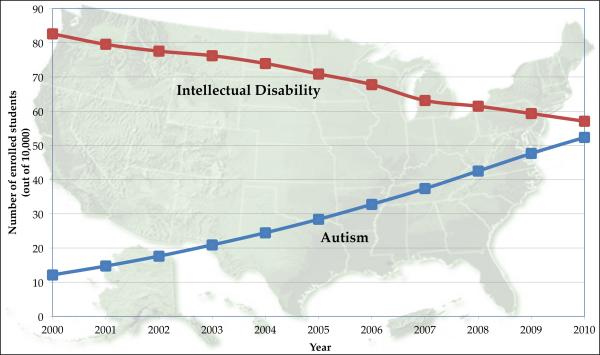Autism Is Not On The Rise

Autism is being diagnosed more than ever, but that has nothing to do with the number of children who actually have autism. It's confusing
Autism was virtually unheard of back in 1975, when the diagnosis rate was roughly 1 in 5,000. But by 2002, that number had skyrocketed to 1 in 150. By 2012, 1 in 68. Grieving parents have variably blamed jet contrails, GMOs and life-saving vaccines for the spike in autism cases. But the reasons may be far more benign than the latest conspiracy theory would suggest, according to a new study in the American Journal of Medical Genetics.
Autism isn’t on the rise—but autism diagnosis is.
Here’s how that works: In 1975, physicians examined thousands of children every year who exhibited signs of autism—the sort of symptoms on the autism spectrum that any modern doctor would flag accordingly. But back then, doctors often classified autistic children as “intellectually disabled” or “learning disabled”. Those children received special attention in school under the U.S. Individuals with Disabilities Education Act—the same attention afforded to autistic children—but they were never officially labeled “autistic”.
Over the past fifteen years, our understanding of Autism Spectrum Disorder has evolved dramatically. Because of some recent, controversial changes to the Diagnostic and Statistical Manual (DSM-V), more children than ever are being diagnosed as autistic, because what constitutes autism has been redefined. That could fool some parents into thinking that autism is on the rise, even when it’s not.

Rates of special needs students are dropping, even as autism rates rise.
The Centers for Disease Control and Prevention have been saying this for years, but until now there wasn’t much science to back up its claim. So in a new study, researchers mapped out the number of children who benefitted from special education between 2000 and 2010, and found that, while the number of special needs children remained constant over that decade, the number of children diagnosed with autism rose by a factor of five.
That suggests that the increase in autism cases is due to a shift in classification, not in how many people have the disorder. In other words, there were likely always this many autistic people in the U.S., but we just didn’t label them as autistic. Now that we understand it better, we diagnose it more often.
“Diagnosis is greatly complicated, which affects the perceived prevalence of autism and related disorders,” Santhosh Girirajan, professor of biochemistry at Penn State University and lead author of the study, said in a prepared statement. “Every patient is different and must be treated as such.”
Оставить комментарий
Для комментирования необходимо войти через
![]() Вконтакте
Вконтакте